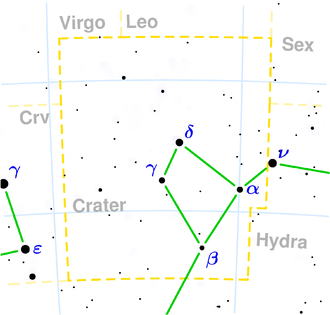NGC 3676
| Galaxie NGC 3676 | |
|---|---|
 | |
| SDSS-Aufnahme | |
| AladinLite | |
| Sternbild | Becher |
| Position Äquinoktium: J2000.0, Epoche: J2000.0 | |
| Rektaszension | 11h 25m 37,5s[1] |
| Deklination | -11° 08′ 23″[1] |
| Erscheinungsbild | |
| Morphologischer Typ | SA(rs)bc pec[1][2] |
| Helligkeit (visuell) | 13,7 mag[2] |
| Helligkeit (B-Band) | 14,7 mag[2] |
| Winkelausdehnung | 0,8′ × 0,7′[2] |
| Positionswinkel | 140°[2] |
| Flächenhelligkeit | 13,1 mag/arcmin²[2] |
| Physikalische Daten | |
| Rotverschiebung | 0.019043 ± 0.000150[1] |
| Radialgeschwindigkeit | (5709 ± 45) km/s[1] |
| Hubbledistanz vrad / H0 | (248 ± 18) · 106 Lj (76,1 ± 5,4) Mpc [1] |
| Geschichte | |
| Entdeckung | Frank Muller |
| Entdeckungsdatum | 1886 |
| Katalogbezeichnungen | |
| NGC 3676 • PGC 35131 • MCG -02-29-029 • 2MASX J11253748-1108225 • | |
NGC 3676 ist eine elliptische Galaxie vom Hubble-Typ E-S0 im Sternbild Becher. Sie ist schätzungsweise 217 Millionen Lichtjahre von der Milchstraße entfernt.
Das Objekt wurde im Jahre 1886 von Frank Muller entdeckt.[3]
Weblinks
Einzelnachweise
Auf dieser Seite verwendete Medien
Autor/Urheber: Sloan Digital Sky Survey, Lizenz: CC BY 4.0
The sky image is obtained by Sloan Digital Sky Survey, DR14 with SciServer.
Angle of view: 4' × 4' (0.3" per pixel), north is up.
Details on the image processing pipeline: https://www.sdss.org/dr14/imaging/jpg-images-on-skyserver/



